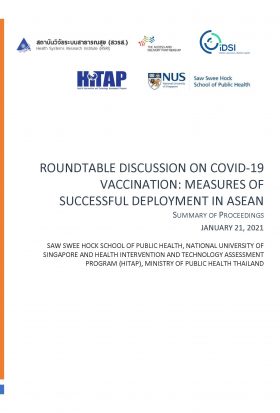This website uses cookies so that we can provide you with the best user experience possible. Cookie information is stored in your browser and performs functions such as recognising you when you return to our website and helping our team to understand which sections of the website you find most interesting and useful.
Mission Report: Roundtable Discussion on COVID-19 Vaccination: Measures of Successful Deployment in ASEAN

Details
Introduction
The world has been in the grip of the COVID-19 pandemic for over a year, costing many lives and bringing the ways of the world to a grinding halt. Among the strategies to respond to the pandemic, governments and the global community invested in developing vaccines. Those investments began to bear fruit towards the end of 2020, with two vaccines approved for emergency use by the United States Food and Drug Administration (US FDA), showing high levels of effectiveness. Other vaccines such as one developed by AstraZeneca have also shown promising results.
Development of effective vaccines is, however, only the beginning. As countries scramble to procure and deliver vaccines in an effort to protect their people and return their economies to pre-pandemic levels, there are many potential hurdles, from the logistics of vaccine distribution to vaccine hesitancy in the population. The challenges are particularly acute for low-and-middle income countries (LMICs) that need to implement vaccine policies within a short timeframe and with limited resources. It is vital that nations recognise and tackle these hurdles as soon as possible, and start to think, too, about how to measure their levels of success against the virus.
To this end, the Saw Swee Hock School of Public Health (SSHSPH) at the National University of Singapore (NUS), in collaboration with the Health Intervention and Technology Assessment Program (HITAP), Ministry of Public Health, Thailand, organised a Roundtable to discuss strategies and challenges for efficient vaccine delivery in countries in the Association of Southeast Asian Nations (ASEAN) and India, and to consider a common framework around what will constitute successful deployment of the vaccine in this region. This report summarises the key themes from the Roundtable discussion with background documents for the Roundtable included in the Appendices.




